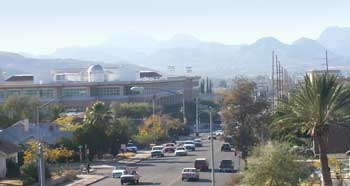|

 |
 At
present, 45 million people live in the southwestern United States, which
also contains some of the most productive agricultural lands in the Nation.
Because most of the surface water in the region has been appropriated,
the search for new water supplies emphasizes development of ground water
resources and new types of conjunctive use related to artificial recharge
and effluent discharges. Ground water, used with surface water, is of
paramount importance to communities and agriculture in this rapidly growing
region. Availability and sustainability of ground-water resources are
measured in terms of changes in water levels and water budgets, changes
in streamflow discharge from ground-water systems, and stability of riparian
ecosystems dependent on shallow ground water. Because of potential diminution
of riparian areas, management of ground-water dependent riparian ecosystems
is assuming critical importance in the management of southwestern water
supplies. At
present, 45 million people live in the southwestern United States, which
also contains some of the most productive agricultural lands in the Nation.
Because most of the surface water in the region has been appropriated,
the search for new water supplies emphasizes development of ground water
resources and new types of conjunctive use related to artificial recharge
and effluent discharges. Ground water, used with surface water, is of
paramount importance to communities and agriculture in this rapidly growing
region. Availability and sustainability of ground-water resources are
measured in terms of changes in water levels and water budgets, changes
in streamflow discharge from ground-water systems, and stability of riparian
ecosystems dependent on shallow ground water. Because of potential diminution
of riparian areas, management of ground-water dependent riparian ecosystems
is assuming critical importance in the management of southwestern water
supplies.
The Southwestern
Ground-water Resources Project is a 5-year study of ground-water and surface-water
interactions and their effects on the availability and sustainability
of ground-water supplies in the Southwest. The project chief is Stanley
A. Leake, Tucson office of the Arizona District, U.S. Geological Survey.
The study area includes aquifer systems in the arid to semiarid basins
in southwestern states of
California, Nevada, Utah, Arizona, New Mexico. The main focus topics of
the project are:
- Regional
synthesis of information on the interaction
of ground water and surface water.
- Development
of improved methods of quantifying inflow to ground-water systems from
streams and application of these recharge
methods in the Southwest.
- Assessments
of the effects of ground-water development on riparian
systems.
- Assessments
of the effects of climate variations
on recharge to and discharge from ground-water systems.
- Development
of improved methods of simulating interaction of surface water and ground
water.
 This
study will use existing and developing techniques to provide fundamental
information about the relations between ground water and surface water
in the Southwest. Study results will augment the current capacity to
understand the impacts of past ground-water development, current use,
and climatic change on associated surface-water systems, and will provide
criteria that will enable estimation of the effects of future hydrogeologic
impacts. Synthesis of information will provide the basis for future
monitoring. This
study will use existing and developing techniques to provide fundamental
information about the relations between ground water and surface water
in the Southwest. Study results will augment the current capacity to
understand the impacts of past ground-water development, current use,
and climatic change on associated surface-water systems, and will provide
criteria that will enable estimation of the effects of future hydrogeologic
impacts. Synthesis of information will provide the basis for future
monitoring.
New and existing
methodologies used will have immediate transfer value both within and
outside of the Southwest, particularly in areas having similar climatic
and hydrogeologic conditions. Integration of the products of this study
will provide a basis on which to examine the impacts of historic and
present ground-water development on riparian systems in arid to semiarid
climates.
|

![]()
